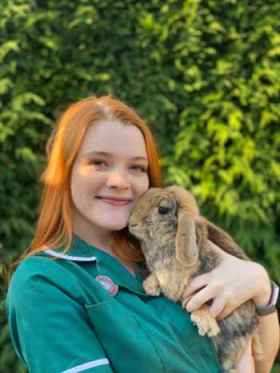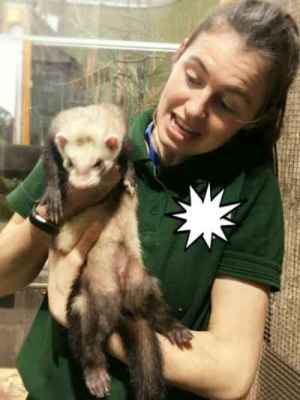FAWSE success at Post graduate research day
On the 8th of June 2022, RVC held it’s annual post graduate research day at our Hawkshead Campus. Post graduates across the RVC showed off the hard work they are putting into their varying projects with impacts statements, presentations and posters. Our Animal Welfare Science and Ethics students represented the group fantastically, bringing home some awards too, listed below. Congratulations to everyone involved.
- Impact statements (judged by Head of Knowledge Exchange and Commercialisation and Head of Graduate School): Winner Maria Jackson Do lop-eared rabbits have more dental and aural disease than erect-eared rabbits? Analysis of data describing rabbits under UK primary veterinary care.

- Impact statement runner up: Bluebell Brown Optimising function and uptake of an ethical framework tool for decision-making across equestrian disciplines.
Bluebells Impact statement:
Britain is home to 874 thousand horses, with 27 million people reporting an interest in the horse industry (BETA, 2019). Equestrianism is a popular multidiscipline sport providing a range of benefits to many stakeholders, including mental and physical health for human/horse athletes, socialisation and spectator enjoyment, direct/indirect employment, and an economic contribution of eight billion (Frey and Eitzen, 1991; Campbell, 2016; BHC, 2019). However, half of this sporting partnership is sentient but non- consenting, and the use of horses in sport can pose physical and psychological risks to the horse. The need for an ‘ethic’ to guide this sector’s activity has been acknowledged, and the social licence for horse sport is increasingly questioned (Campbell, 2021). In 2021, Campbell’s framework for ethical decision-making within horse sport was tested and refined by ‘elite competitive’ stakeholder feedback. The framework provides a practical, consistent, group decision-making tool, applicable across equestrian disciplines on a variety of ethical dilemmas, to minimise negative welfare effects while promoting positive welfare. The current project builds on this research. Facilitated through a multidisciplinary mixed methodology, the overall aim is to enhance the welfare impact of the ethical decision-making framework, by optimising its function and uptake. Achieving the overall research aim could deliver policy-related, societal, and economic impact.
Use of the framework process can result in transparent and evidence-based output, which can inform regulatory policy within elite horse sport, and potentially at grassroots level, which is currently being tested. The methodology of the preceding and current project ensures stakeholder participation from the start, to guarantee that all research stages are informed by the end user. To maintain a sense of stakeholder ‘ownership,’ which could influence future uptake and therefore policy-related impact, regular updates on the progress of the framework are being provided to ‘elite’ stakeholders. World Horse Welfare, the project funders, will hold a stakeholder conference at the end of the project, to launch the framework at grassroots level. Invitees will include regulators of grassroots organisations such as the Pony Club, Riding for the Disabled Association and British Riding Clubs.
The framework’s harm: benefit analysis necessitates consideration of decision consequences for diverse direct and indirect stakeholders (e.g., environment), thereby advancing one health. This analysis may also cause a perspective shift in the user, potentially motivating behaviour change. Uptake of the framework by owners, riders, and training organisations etc has the potential to improve horse welfare, by enabling the ethical consideration of everyday management situations. Towards the end of this project, to motivate uptake, and therefore maximise societal impact, two distinct grassroots and elite level ‘value-added’ influencer campaigns will be launched. Uptake and use of the framework could generate an awareness within the general public, animal welfare supporters and spectators, of a shift towards an ethical and welfare orientated ethos within all levels of horse sport, thereby increasing social licence. To increase awareness, research output and influencer campaigns will feature across all social media and within lay press articles. Increasing social licence may then generate economic impact by retaining, or increasing, an annual consumer spend of £4.7 billion on equestrian products and services (BETA, 2019).
Optimising the function and uptake of the framework may have significant impact for sport horses, through identification of and prevention against avoidable, unnecessary risk and maximisation of positive welfare, at elite and grassroots levels, inside of competition and out of it.

- Graphical abstracts (judged by members of the Researcher Association): Highly Commended Olivia Edgar-Price Exploring risk factors for visually-mediated abnormal repetitive behaviours in the domestic dog

- Presentation abstracts (voted for by RVC staff and students): Runner up Alice Dancer Does cognitive stimulation reduce behavioural and neural measures of ‘boredom’ in laboratory ferrets?
Boredom is an aversive affective state, which is likely to be a pervasive animal welfare problem, although how animals experience boredom and how it can be mitigated against is understudied. Moreover, measuring affective states in non-human animals is challenging, and boredom offers additional complexities by resulting in both high and low arousal behaviours, and because potential behavioural indicators also occur in other states, such as frustration. In this thesis, using ferrets as a model, we aim to improve understanding of animal boredom, and in particular whether behavioural and neural measures of boredom are reduced by provision of cognitive stimulation.
Firstly, through a multi-sector survey, we assessed caretakers’ perceptions of ferret boredom and the scope of different forms of cognitive stimulation currently used, including environmental enrichment (EE) and positive reinforcement training (PRT). Findings show a proportion of caretakers from all sectors are risking ferret boredom via management practices, e.g. through restrictive housing, with 9.4% of respondents (n=71/754) using single-level cages/hutches. Additionally, owners who doubted ferrets could experience boredom provided significantly fewer EE types (T1,588=2.651; P=0.008), suggesting a consequence of caretakers’ beliefs on their animals’ welfare.
Secondly, using 16 laboratory ferrets, we explored whether provision of stimulation reduces behavioural measures of boredom and investigated the role of novelty and complexity in EE. In a subset of two ferrets, we validated behavioural measures by assessing differences in neural oscillations. Results to date, for one measure – sleep quality – showed no difference between novel and complex treatments, although sleep quality was significantly improved by provision of enclosed sleeping EE (LMM: F(3)=3.06, p=0.04). Finally, we investigated whether learning a new behaviour through PRT reduces one particular behavioural measure of boredom, sensation seeking. Analyses are ongoing.
Our research will improve fundamental knowledge around measuring animal boredom, and will have applied outputs, including recommendations for reducing animal boredom.

